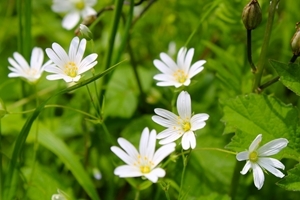Greater stitchwort
A common sight along hedgerows and roadside verges, a constellation of beautiful delicate star-like flowers, full of folklore
 The greater stitchwort (Stellaria holostea) is widespread and a common sight along the countryside roadside verges, woodlands, grassy banks and hedgerows down here in Hampshire at this time of year. It appears seemingly out of nowhere in April, announcing spring is here and that summer is on its way as it disappears as quickly as it appeared in June.
The greater stitchwort (Stellaria holostea) is widespread and a common sight along the countryside roadside verges, woodlands, grassy banks and hedgerows down here in Hampshire at this time of year. It appears seemingly out of nowhere in April, announcing spring is here and that summer is on its way as it disappears as quickly as it appeared in June.
Greater stitchwort has large, delicate, star-like white flower, that casts a constellation wherever it grows. The flowers are bright white with five white petals, each deeply notched and almost divided into two – so much so, a friend of mine child calls it “bunny flower” as it looks like the two ears of a rabbit. The flowers are larger (2-3cm across) than its relative, lesser stitchwort (0.5-1cm across), which flowers later from May to September, and its green leaves are grass-like in appearance and its brittle stems are square. This lovely little flower blooms from April to June and as the seed capsules ripen in the sun, they have an explosive mechanism and can be heard ‘popping’ in late spring, catapulting the seed far and wide, which is why it is sometimes called ‘popguns’ and ‘poppers’.
Greater stitchwort has many other common names, including ‘wedding cakes’, ‘Star-of-Bethlehem’, ‘daddy’s-shirt-buttons’, ‘milkmaids’, ‘brassy button’, and ‘snapdragon’ – the latter because its stems are brittle and easily break.
This plant is a valuable early source of nectar to many invertebrates such as bees, butterflies and hoverflies, and is the foodplant of the marsh pug, plain clary and yellow underwing moths. Not only is this plant valuable to wildlife, but this plant was once used as a herbal remedy for a stitch (that nasty pain in the side after running), hence the name ‘stitchwort’. It has also been called the ‘poor man’s buttonhole’, presumably because it was once used as a buttonhole.
As always, I like to look into the folklore and this plant doesn’t disappoint! Some say that if you pick greater stitchwort, you will cause a thunderstorm, and in Cornwall it was believed that greater stitchwort was the property of the pixies and picking it would anger them – often resulting in said pixies enchanting you!
So, when you are out, please don’t pick any and cause a thunderstorm, as I am busy doing lots of fieldwork and can’t afford a day indoors. And beware... you might get enchanted by pixies!
Megan Lock
Advisory